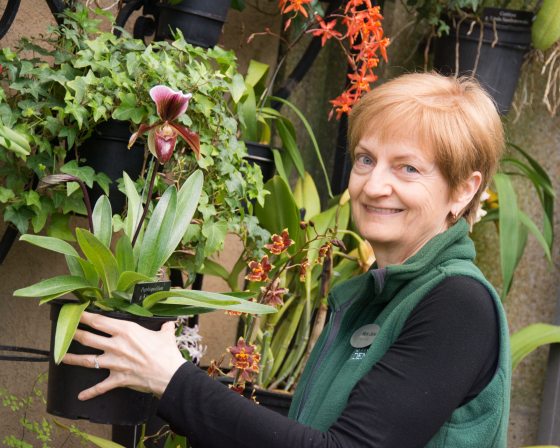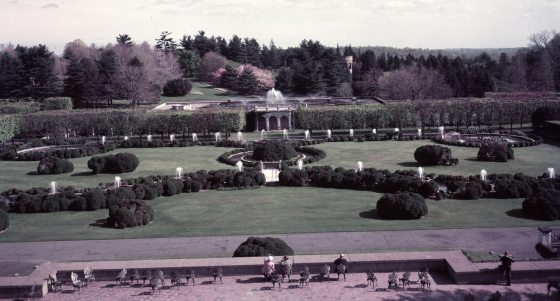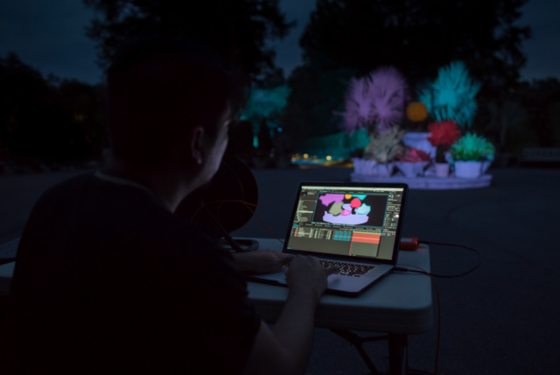Our Blog
Blog All Items Title
All Recent Articles

Celebrating Our Founder, Fountains, and Flowing Water
In July 1906, Pierre S. du Pont purchased the rights to the historic Peirce’s Park and surrounding lands, thereby establishing Longwood Gardens. One hundred and eleven years after Mr. du Pont’s purchase, we commemorate this historic act with our Founder’s Day weekend of festivities.

A Flourish of Fountains
Longwood is home to the most significant fountain collection in North America and in June we celebrate all the fountains in our Gardens. From Pierre S. du Pont’s first single-jet fountain on the Flower Garden Walk to the 1,719-jet Main Fountain Garden, guests can learn more about Longwood’s fountains with tours and two new exhibits...

The Way Things Work Now: A Community Read
What does our 2017 Community Read selection, The Way Things Work Now, have in common with our Main Fountain Garden? Both are works of art and engineering that engage the imagination. Both were created by masters of their fields—David Macaulay is an award-winning author whose words and drawings help us imagine how technology works, while Pierre S. du Pont was a visionary business leader whose love of fountains placed that technology on spectacular display. It’s one thing to stand in awe of such technological wonders—and quite another thing to wonder, and to seek to understand. That’s what David Macaulay and this year’s Community Read do so well—they make us wonder not only about things that inspire awe, but also about things we might otherwise take for granted.

Growing Together at the Annual Longwood Graduate Program Symposium
On Friday, March 3, the Longwood Graduate Students presented their annual symposium entitled “Growing Together: Cultivating Change in the Economic Landscape.” The daylong educational experience sought to engage attendees in big picture thinking. From how the public horticulture industry uses vacant city lots for urban farming to the way public gardens can advocate for their mission while leveraging current events and politics, the riveting speakers and crowd discussions left no mind untilled.

Longwood Releases Clivia miniata ‘Longwood Sunset’
With soft, pastel-colored flowers, Clivia miniata ‘Longwood Sunset’ is a color breakthrough for our 40-year-old clivia breeding program. Apricot and peach tones imbue the reflexed, overlapping tepals with hues of a blushing sunset. Before being named and released, ‘Longwood Sunset’ received multiple awards at the North American Clivia Show in 2014. This year ‘Longwood Sunset’ will be exclusively available for purchase through a partnership with White Flower Farm.

Reading in Community
Have you ever wondered how your smartphone works? How about a telescope? Or helium pants? This year, the Longwood Gardens Community Read invites you to explore the wonders of science, technology, and engineering that shape our world. Pick up this year’s titles—The Way Things Work Now by David Macaulay, and Rosie Revere, Engineer by Andrea Beaty—to find fun and fascinating answers to these questions, and the inspiration to ask many more.

Our Vital Volunteers
Orchids are one of Longwood Gardens’ oldest and largest plant collections, with more than 2,200 different hybrids and species. On any given day, several hundred blooms are on display in the Orchid House in the Conservatory. For the past two years, this extensive and historic collection has been managed by Greg Griffis, Longwood’s orchid grower. As Greg acknowledges, a lot of work is required to keep all these orchids healthy and flourishing, and he relies on the help of a team of dedicated volunteers. I’m privileged to be one of them!

A Gardener’s Tour of Orchid Extravaganza
The 2017 Orchid Extravaganza at Longwood Gardens is certainly the most outstanding display I’ve seen here since we started this exhibition! There are more orchids in more places than you could hope to enjoy in one morning. The Longwood team has scoured the orchid world to bring you some of the most dynamic selections available to gardeners! The careful composition of colors and textures is what really makes this extravaganza so special.

Identifying Orchids

Creating a Showstopper: Our Living Tree
Every season, our gardeners strive to create new and innovative displays while preserving the spirit and traditions of A Longwood Christmas. For this year’s display, Senior Gardener Koa Kanamee spearheaded the brainstorming, design, and execution of the largest “Living Tree” in Longwood’s history. Standing in the flooded Fern Floor of the Exhibition Hall at 30 feet tall and 20 feet wide, the tree boasts 1,300 individually potted plants, including red poinsettias, white Euphorbia fulgens, Canary ivy, Hedera canariensis, white Phalaenopsis orchids, and hand-painted winged Euonymus.

The Sounds of the Season
Christmas at Longwood: gorgeous floral displays? Check. Beautiful, elegant decorations throughout the Conservatory? Check. Hundreds of thousands of lights sparkling in our outdoor gardens? Check. Music of the season? Check, check, and double check. Anyone who has visited Longwood Gardens or who has learned a little bit of our history will know that music and the performing arts have always been an important part of our Gardens.

Euphoria Over Euphorbia: Our Poinsettia Panel
Every year during A Longwood Christmas, we feature a small, tucked-away display of poinsettia cultivars in our North Passage (adjacent to our Bonsai display). These varieties are part of our efforts to continually improve the quality of our horticulture displays and introduce new plants to our guests. Midway through the Christmas season, a panel of gardeners, growers, researchers, and our display designer meet up to evaluate the poinsettias and decide which plants we want to grow in the future. Here are some of the panel’s thoughts from this year.

Longwood Gardens Achieves ArbNet Level IV Accreditation
When our founder, Pierre S. du Pont, purchased the property where Longwood Gardens now stands, he did so to rescue and conserve an exceptional collection of historic trees originally planted by the Peirce family. Peirce family members, who began farming the land in the 1700s, were interested in natural history and planted an arboretum covering 15 acres. Since the time of du Pont’s purchase, we have continued to protect the original stand of trees—now called Peirce’s Park—while developing and adding to the collection.

Little Jewel Wins Big
For a second season, staff members from all corners of the Gardens used their creative talents to design garden plots in our Trial Garden—all while engaging in a friendly competition. The process is a way for us to showcase new plants for our guests, evaluate each plant’s suitability for our display, and spotlight our staff’s design talents. Participants selected three to eight plants from a list of more than 160 plant species and cultivars. This year we had a total of 15 different combinations, including the top three combinations from last year's Trial Garden. The results are in!

Creating Immersive Realities and Virtual Experiences
The final installment of Nightscape's Artist & Friends wrapped up the speaker series with a discussion about the future of virtual experiences. Kevin Ritchie and Mark McCallum of Klip Collective joined founding member Ricardo Rivera to discuss the future of virtual reality and its relationship to fields as varied as art, design, healthcare, and military training; and the place of human agency within art and immersive experiences.

Nightscape: Soundscapes 2.0
The latest installment of the Nightscape Artist & Friends Speaker Series on September 9 provided a continuation of 2015’s July topic: the importance of music to the Nightscape experience. Justin Geller from Pink Skull rejoined Ricardo Rivera, director of Nightscape and founding member of Klip Collective, and fellow Pink Skull composer Julian Grefe joined the conversation via Skype from Germany. Last year’s panel described the role of Pink Skull in the development of Nightscape, especially their contribution to the Silver Garden and Palm House. Two major changes to this year’s installations extended the collaboration between Pink Skull and Klip Collective and focused on Peirce’s Woods and the Waterlily Display.

Maintaining Tradition: A Boxwood Story
The pinnacle of Pierre S. du Pont’s love for gardening is set to reopen next summer to the delight of thousands of eager guests. Meticulous planning went into the revitalization of the Main Fountain Garden, with much consideration given to preserving the legacy of Mr. du Pont and the property he purchased in 1906. In addition to saving the arboretum that the Peirce brothers started in 1798, Pierre became the steward of a large collection of boxwood that was planted among the trees leading to the Peirce home.

Plant Exploration in the Republic of Georgia
Plant exploration plays a vital role in Longwood’s efforts to bring new plants into the Gardens. We travel to targeted regions throughout the world to find new plant species, which we then bring home to grow and evaluate. I recently finished a collection trip to the floristically rich Republic of Georgia; the goal of the trip was to explore seldom-visited regions of the country to search for and collect new species of woody and herbaceous plants.

Nightscape: The Art of Projection Mapping
The return of Nightscape: A Light and Sound Experience by Klip Collective means the return of the Friday night Artist & Friends Speaker Series. The first of three installments, on Friday, August 12, included Ricardo Rivera, founding member of Klip Collective and creator of Nightscape, and Thom Roland, Art Director at Klip Collective. Both artists discussed the basics of projection mapping and various uses for this medium; the overlap of their respective roles at their studio and behind the scenes of Nightscape; and a few of the changes they made to the 2016 version of Nightscape.

Butterflies of Longwood
Like many gardens throughout our region, Longwood has been doing its part to help the monarch butterfly. A wonderful byproduct of these efforts is that many other native butterflies also benefit. In fact, Longwood's Meadow Garden is home to dozens of different butterfly species, with more being identified each year as the landscape matures. While many of these butterflies are important pollinators like the monarch, others will ignore flowers almost entirely, and are drawn to the Meadow Garden for other reasons. Indeed, in order to enjoy these beautiful insects, we need to manage their habitat in ways that benefit all of their different life stages—larva (caterpillars), pupa (chrysalises), and adults (butterflies).
